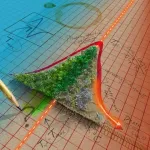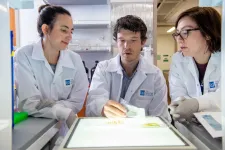INFORMATION:
Funding for this research was provided by the National Aeronautics and Space Administration (grant NNX12AK12G), National Science Foundation (NSF) East-Asia Pacific Summer Institute Fellowship (1614404), the Royal Society of New Zealand Foreign Partnership Programme (EAP- UOW1601) and the New Zealand Marsden Fund (grant 16-UOW-027). This work used eddy covariance data acquired and shared by the FLUXNET community, including AmeriFlux, AfriFlux, AsiaFlux, CarboAfrica, CarboEuropeIP, CarboItaly, CarboMont, ChinaFlux, Fluxnet-Canada, GreenGrass, ICOS, KoFlux, LBA, NECC, OzFlux-TERN, TCOS-Siberia and USCCC networks.
Earth to reach temperature tipping point in next 20 to 30 years, new NAU study finds
2021-01-13
(Press-News.org) Earth's ability to absorb nearly a third of human-caused carbon emissions through plants could be halved within the next two decades at the current rate of warming, according to a new study in Science Advances by researchers at Northern Arizona University, the Woodwell Climate Research Center and the University of Waikato, New Zealand. Using more than two decades of data from measurement towers in every major biome across the globe, the team identified a critical temperature tipping point beyond which plants' ability to capture and store atmospheric carbon--a cumulative effect referred to as the "land carbon sink"--decreases as temperatures continue to rise.
The terrestrial biosphere--the activity of land plants and soil microbes--does much of Earth's "breathing," exchanging carbon dioxide and oxygen. Ecosystems across the globe pull in carbon dioxide through photosynthesis and release it back to the atmosphere via the respiration of microbes and plants. Over the past few decades, the biosphere has generally taken in more carbon than it has released, mitigating climate change.
But as record-breaking temperatures continue to spread across the globe, this may not continue; the NAU, Woodwell Climate and Waikato researchers have detected a temperature threshold beyond which plant carbon uptake slows and carbon release accelerates.
Lead author Katharyn Duffy, a postdoctoral researcher at NAU, noticed sharp declines in photosynthesis above this temperature threshold in nearly every biome across the globe, even after removing other effects such as water and sunlight.
"The Earth has a steadily growing fever, and much like the human body, we know every biological process has a range of temperatures at which it performs optimally, and ones above which function deteriorates," Duffy said. "So, we wanted to ask, how much can plants withstand?"
This study is the first to detect a temperature threshold for photosynthesis from observational data at a global scale. While temperature thresholds for photosynthesis and respiration have been studied in the lab, the Fluxnet data provide a window into what ecosystems across Earth are actually experiencing and how they are responding.
"We know that the temperature optima for humans lie around 37 degrees Celsius (98 degrees Fahrenheit), but we in the scientific community didn't know what those optima were for the terrestrial biosphere," Duffy said.
She teamed up with researchers at Woodwell Climate and the University of Waikato who recently developed a new approach to answer that question: MacroMolecular Rate Theory (MMRT). With its basis in the principles of thermodynamics, MMRT allowed the researchers to generate temperature curves for every major biome and the globe.
The results were alarming.
The researchers found that temperature "peaks" for carbon uptake--18 degrees C for the more widespread C3 plants and 28 degrees C for C4 plants--are already being exceeded in nature, but saw no temperature check on respiration. This means that in many biomes, continued warming will cause photosynthesis to decline while respiration rates rise exponentially, tipping the balance of ecosystems from carbon sink to carbon source and accelerating climate change.
"Different types of plants vary in the details of their temperature responses, but all show declines in photosynthesis when it gets too warm," said NAU co-author George Koch.
Right now, less than 10 percent of the terrestrial biosphere experiences temperatures beyond this photosynthetic maximum. But at the current rate of emissions, up to half the terrestrial biosphere could experience temperatures beyond that productivity threshold by mid-century--and some of the most carbon-rich biomes in the world, including tropical rainforests in the Amazon and Southeast Asia and the Taiga in Russia and Canada, will be among the first to hit that tipping point.
"The most striking thing our analysis showed is that the temperature optima for photosynthesis in all ecosystems were so low," said Vic Arcus, a biologist at the University of Waikato and co-author of the study. "Combined with the increased rate of ecosystem respiration across the temperatures we observed, our findings suggest that any temperature increase above 18 degrees C is potentially detrimental to the terrestrial carbon sink. Without curbing warming to remain at or below the levels established in the Paris Climate Accord, the land carbon sink will not continue to offset our emissions and buy us time."
ELSE PRESS RELEASES FROM THIS DATE:
Taking the lab into the ocean: A fleet of robots tracks and monitors microbial communities
2021-01-13
Researchers from MBARI, the University of Hawai'i at Mānoa (UH Mānoa), and Woods Hole Oceanographic Institution, after years of development and testing, have successfully demonstrated that a fleet of autonomous robots can track and study a moving microbial community in an open-ocean eddy. The results of this research effort were recently published in Science Robotics.
Autonomous robotic fleets enable researchers to observe complex systems in ways that are otherwise impossible with purely ship-based or remote sensing techniques. In a time when the COVID-19 ...
Earth's terrestrial ecosystems may transition from carbon sinks to carbon sources within decades
2021-01-13
Rising temperatures could trigger Earth's terrestrial ecosystems to transition from carbon sinks to carbon sources in the next 20 to 30 years, according to data from the world's largest continuous carbon monitoring network. The researchers suggest that up to half of land ecosystems could reach this tipping point - when plants begin to release carbon into the atmosphere faster than they sequester it - by 2100 under a business-as-usual emissions scenario. However, biomes that store the most carbon, including rainforests and Taiga forests, may lose more than 45% of their ...
How does your computer smell?
2021-01-13
A keen sense of smell is a powerful ability shared by many organisms. However, it has proven difficult to replicate by artificial means. Researchers combined biological and engineered elements to create what is known as a biohybrid component. Their volatile organic compound sensor can effectively detect odors in gaseous form. They hope to refine the concept for use in medical diagnosis and the detection of hazardous materials.
Electronic devices such as cameras, microphones and pressure sensors enable machines to sense and quantify their environments optically, acoustically and physically. Our sense of smell however, despite being one of nature's most primal senses, has proven very difficult ...
Scientists modeled protein behavior of archaeal viruses to crack protein folding mystery
2021-01-13
Scientists from the Pacific Quantum Center of Far Eastern Federal University (FEFU) figured out how the AFV3-109 protein with slipknot structure folds and unfolds depending on temperature. The protein is typical for the viruses of the oldest single-celled organisms that can survive in the extreme conditions of underwater volcanic sources - archaea. The research outcome appears in PLOS ONE.
Using numerical methods and applying quantum field theory that is unique for the study of proteins, the FEFU scientists have probed into the folding topology (scheme) ...
'Ocean 100': Small group of companies dominates ocean economy
2021-01-13
DURHAM, N.C. - Most of the revenues extracted from use of the world's oceans is concentrated among 100 transnational corporations, which have been identified for the first time by researchers at Duke University and the Stockholm Resilience Centre at Stockholm University.
Dubbed the "Ocean 100," these "ocean economy" companies collectively generated $1.1 trillion in revenues in 2018, according to research published Wednesday in the journal Science Advances. If the group were a country, it would have the world's 16th-largest economy, roughly equivalent to the gross domestic product (GDP) of Mexico.
"Now that we know who some of the biggest beneficiaries from the ocean economy are, this can help improve transparency relating to sustainability and ocean ...
Robotic swarm swims like a school of fish
2021-01-13
Schools of fish exhibit complex, synchronized behaviors that help them find food, migrate and evade predators. No one fish or team of fish coordinates these movements nor do fish communicate with each other about what to do next. Rather, these collective behaviors emerge from so-called implicit coordination -- individual fish making decisions based on what they see their neighbors doing.
This type of decentralized, autonomous self-organization and coordination has long fascinated scientists, especially in the field of robotics.
Now, a team of researchers at the Harvard John A. Paulson School of Engineering and ...
Researchers identify nanoparticles that could deliver therapeutic mRNA before birth
2021-01-13
Philadelphia, January 13, 2021--Researchers at Children's Hospital of Philadelphia and the School of Engineering and Applied Science at the University of Pennsylvania have identified ionizable lipid nanoparticles that could be used to deliver mRNA as part of fetal therapy. The proof-of-concept study, published today in Science Advances, engineered and screened a number of lipid nanoparticle formulations for targeting mouse fetal organs and has laid the groundwork for testing potential therapies to treat genetic diseases before birth.
"This is an important first step in identifying nonviral mediated approaches for delivering cutting-edge therapies before birth," said co-senior author William H. Peranteau, MD, an attending surgeon in the Division of ...
New insights into the control of inflammation
2021-01-13
PHILADELPHIA -- (Jan. 13, 2021) -- Scientists at The Wistar Institute discovered that Early Growth Response 1 (EGR1), a protein that turns on and off specific genes during blood cell development, inhibits expression of pro-inflammatory genes in macrophages. As part of their function to protect the body against pathogens, macrophages play a major role in initiation, maintenance, and resolution of inflammation. The discovery expands the understanding of how macrophages are set off and deactivated in the inflammatory process, which is critical in many normal and pathological conditions. These findings were published online in the journal Science Advances.
"By deepening the understanding of the role of EGR1, we ...
COVID-19 vaccine creates incentive to improve our health
2021-01-13
COLUMBUS, Ohio - While we wait for our turn to get vaccinated against SARS-CoV-2, we could - and probably should - use the time to make sure we bring our healthiest emotional and physical selves to the treatment, a new review of previous research suggests.
Ohio State University researchers reviewed 49 vaccine studies in humans dating back 30 years that document how stress, depression and poor health behaviors can negatively affect the body's immune response to vaccination, and how improving health factors can enhance that response.
The impaired immune responses tended to fall into three categories - interference with the ...
In new Skoltech research, 'e-nose' and computer vision help cook the perfect chicken
2021-01-13
Skoltech researchers have found a way to use chemical sensors and computer vision to determine when grilled chicken is cooked just right. These tools can help restaurants monitor and automate cooking processes in their kitchens, and perhaps one day even end up in your 'smart' oven. The paper detailing this research results, supported by a Russian Science Foundation grant, was published in the journal Food Chemistry.
How do you tell that chicken breast on your grill is ready for your plate? You probably look at it closely and smell it to make sure it is done the way you like it. However, if you are a restaurant chef or head cook at a huge industrial ...




